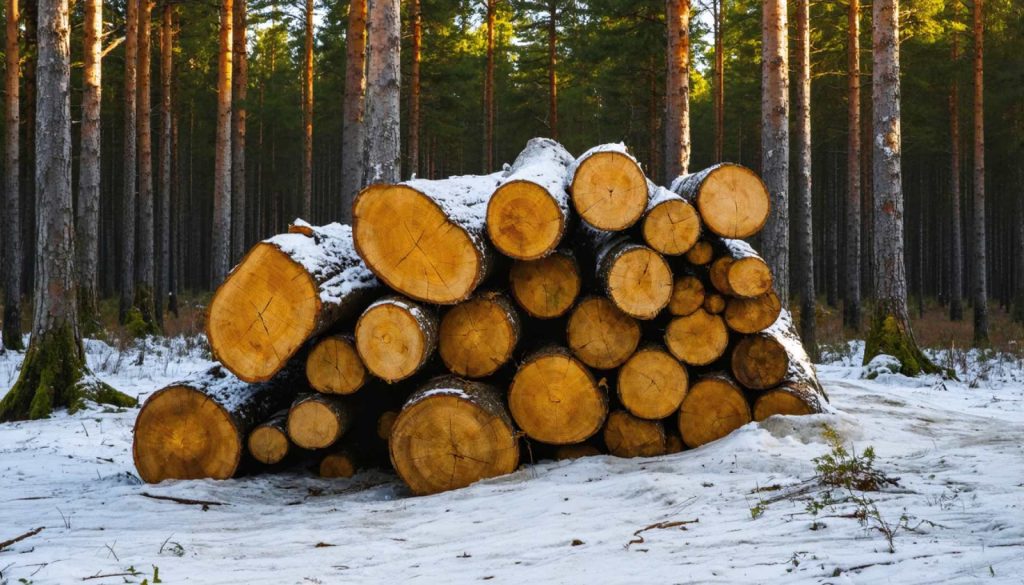
- Finland faces a complex legal dispute over timber rights involving the indigenous Sámi communities and commercial logging companies.
- The Sámi seek legal protection for their ancestral lands, emphasizing sustainable forest management to preserve biodiversity and cultural heritage.
- Logging companies assert commitment to sustainability, citing Finland’s stringent forestry regulations as evidence.
- The conflict highlights global themes, including economic growth versus ecological preservation and indigenous rights.
- The court’s decision could set an international precedent for balancing economic interests with environmental and cultural values.
- The case underscores the need for sustainable practices that respect both economic needs and traditional values.
Majestic pines shiver in the northern wind as Finland finds itself enmeshed in a heated legal battle that has roots as deep as the country’s oldest forests. With over 70% of the nation draped in dense woodland, the forest industry is a pillar of Finland’s economy, providing livelihoods and shaping the cultural landscape. Yet, a fierce dispute over timber rights captures the nation’s attention, pitting tradition against modernization under the arctic sky.
The heart of the conflict throbs in the ancient area of Lapland, where indigenous Sámi communities and commercial logging companies stand on opposing sides. For centuries, the Sámi people have thrived as fishermen and herders, relying on the forests’ resources for their traditional way of life. The recent surge in demand for timber threatens this delicate balance, urging the Sámi to seek legal intervention to protect their ancestral lands from overexploitation.
Enter the courtroom: a modern battleground where tradition and industry clash. The Sámi community argues that their rights, grounded in international agreements like the United Nations Declaration on the Rights of Indigenous Peoples, are under siege. They demand sustainable management of the forests, which they assert is vital for preserving biodiversity and maintaining their cultural heritage.
On the other side, the logging companies wield economic influence and offer assurances of responsible forest management practices. They point to the rigorous Finnish forestry regulations, heralded globally for sustainable management standards, as a testament to their commitment to environmental care.
The case evolves with the intensity of a Nordic thriller. Legal arguments churn like snowflakes in the air, as each side calls upon scientific evidence and expert testimony. The courtroom echoes with debates on sustainable quotas, climate change, and economic growth, reflecting broader global concerns.
Amid this tension, a profound image emerges: the looming shadows of towering trees, both witness and participant in this unfolding drama. These forests contain not just timber, but the whispers of history and the promise of the future.
The court’s decision will reverberate beyond Finland’s borders, serving as a precedent for cases where ecological preservation intersects with economic interests. As the midnight sun casts long shadows across the land, the Finnish forest feud sends a clear message: the world must find ways to honor both economic needs and traditional values, ensuring that the green heartbeat of our planet continues to thrive.
In the end, the case reminds us of an undeniable truth: in the global quest for progress, the roots we cultivate must reach deep into the soil of respect and sustainability. The solution in Finland may well point the way for a world seeking balance in an age of rapid change.
The Hidden Battles of Finland’s Forests: Insights, Realities, and Future Implications
Exploring the Forests of Finland: A Deeper Dive
The majestic forests of Finland, covering over 70% of the nation’s land, are more than an economic powerhouse; they are cultural treasures deeply rooted in the identity and survival of indigenous communities, particularly the Sámi people. The ongoing legal battle over timber rights in Lapland is a microcosm of a larger global narrative of preservation versus progress. Let’s delve deeper into the aspects not fully explored in the source article: the impact of this conflict on the indigenous communities, the logging industry, and the environment.
The Importance of Sustainable Forest Management
1. Indigenous Rights and International Precedents:
The Sámi community’s fight for their ancestral lands is backed by international precedents. The United Nations Declaration on the Rights of Indigenous Peoples emphasizes the need to respect the traditions and sustainable practices of indigenous communities. The court’s decision could set a global precedent for indigenous rights in natural resource management.
2. Economic Value vs. Ecological Cost:
Finland’s forest industry contributes significantly to its GDP, providing jobs and exports. However, the ecological cost of overexploitation—loss of biodiversity, soil erosion, and climate change impacts—must be weighed carefully. Sustainable logging practices are essential, but are they enough to preserve the ecological balance?
Real-World Use Cases and Solutions
1. Community-Led Conservation Projects:
Indigenous-led conservation initiatives, such as those in Canada where indigenous communities manage forestry operations, could be a model for Finland. These projects balance economic gain with preserving cultural heritage and biodiversity.
2. Technological Innovations in Forestry:
Advances in technology, like satellite monitoring and AI, can optimize sustainable forest management. These tools can measure tree growth rates, assess forest health, and prevent illegal logging activities, ensuring a balance between economic needs and ecological preservation.
Industry Trends and Predictions
1. Market Forecast:
The global demand for timber is expected to rise, driven by construction, furniture, and paper industries. The challenge will be meeting this demand without compromising environmental sustainability. Finland’s case could inform industry standards worldwide.
2. Future of Indigenous Rights:
With growing global awareness, the trend is shifting towards recognizing indigenous rights and their ecological knowledge. Legal frameworks might evolve, incorporating traditional ecological wisdom as a critical component of natural resource management.
Controversies and Limitations
1. Balancing Acts:
Finding the equilibrium between development and conservation is contentious. Critics argue that even “sustainable” practices may not fully protect ecosystems. The concept of “sustainable logging” itself is scrutinized—how much logging is truly sustainable without harming biodiversity?
2. Regulatory Challenges:
Even with stringent Finnish forestry regulations, enforcing these laws and ensuring compliance remains a significant challenge, especially in vast and remote forest expanses.
Actionable Tips for Sustainable Practices
– Support Indigenous Products:
Purchase products from indigenous communities to promote their economies and sustainable practices.
– Stay Informed:
Educate yourself about the origins of timber products. Opt for certified products, such as those with a Forest Stewardship Council (FSC) label.
– Advocate for Policy Change:
Get involved in advocacy groups that support sustainable forestry management and indigenous rights.
Conclusion
The forest feud in Finland is a reminder of the delicate balance required between economic development and ecological preservation. Looking forward, embracing sustainable management practices, respecting indigenous rights, and leveraging technological advances are crucial steps in ensuring that Finland’s—and the world’s—forests continue to thrive.
For further exploration on this topic, visit the following site to learn more about sustainable forestry initiatives: Forest Stewardship Council.
By understanding these dynamics, we equip ourselves to champion a future where economic progress does not come at the expense of our planet’s invaluable natural resources.



